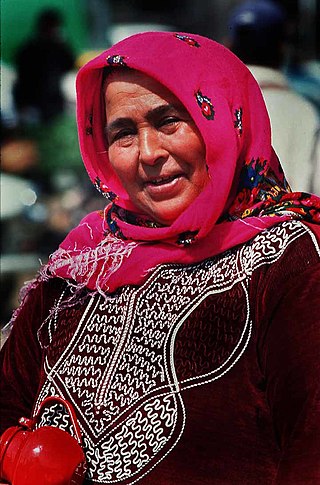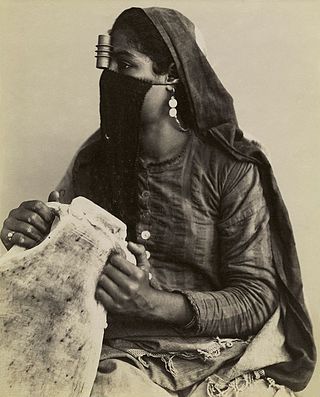
In modern usage, hijab generally refers to various head coverings conventionally worn by many Muslim women. It is similar to the tichel or snood worn by Orthodox Jewish women, certain headcoverings worn by some Christian women, such as the mantilla, apostolnik and wimple, and the dupatta worn by many Hindu and Sikh women. Whilst a hijab can come in many forms, it often specifically refers to a scarf wrapped around the head, covering the hair, neck and ears but leaving the face visible. The use of the hijab has been on the rise worldwide since the 1970s and is viewed by many Muslims as expressing modesty and faith; it has also been worn for purposes of adornment. There is a consensus among Islamic religious scholars that covering the head is either required or preferred, though some Muslim scholars and activists point out that it is not mandated.

A burqa or a burka is an enveloping outer garment worn by some Muslim women which fully covers the body and the face. Also known as a chadaree or chaadar in Afghanistan and Pakistan, or a paranja in Central Asia, the Arab version of the burqa is called the boshiya and is usually black. The term burqa is sometimes conflated with the niqāb even though, in more precise usage, the niqab is a face veil that leaves the eyes uncovered, while a burqa covers the entire body from the top of the head to the ground, with a mesh screen which only allows the wearer to see in front of her.

Islam in France is a minority faith. Muslims are estimated to represent around 4% of the nation's population as per Statista and Le Monde, although Insee claims that in metropolitan France this percentage can reach 10%. After conquering much of the Iberian peninsula, the Umayyad Muslim forces invaded modern day southern France, but were defeated by the Frankish Christian army led by Charles Martel at the Battle of Tours in 732 AD, thus preventing the possible Islamisation of Western Europe. During a later incursion, Muslims established the fortress Fraxinetum. France's Muslim population grew starting in the second half of the 20th century, following immigration from former French colonies and protectorates in Africa and the Middle East.

Islamic clothing is clothing that is interpreted as being in accordance with the teachings of Islam. Muslims wear a wide variety of clothing, which is influenced not only by religious considerations, but also by practical, cultural, social, and political factors. In modern times, some Muslims have adopted clothing based on Western traditions, while others wear modern forms of traditional Muslim dress, which over the centuries has typically included long, flowing garments. Besides its practical advantages in the climate of the Middle East, loose-fitting clothing is also generally regarded as conforming to Islamic teachings, which stipulate that body areas which are sexual in nature must be hidden from public view. Traditional dress for Muslim men has typically covered at least the head and the area between the waist and the knees, while women's islamic dress is to conceal the hair and the body from the ankles to the neck. Some Muslim women also cover their face. However, other Muslims believe that the Quran does not mandate that women need to wear a hijab or a burqa.

A niqāb or niqaab, also known as a ruband, is a long garment worn by some Muslim women in order to cover their entire body and face, excluding their eyes. It is an interpretation in Islam of the concept of hijab, and is worn in public and in all other places where a woman may encounter non-mahram men. Most prevalent in the Arabian Peninsula, the niqab is a controversial clothing item in many parts of the world, including in some Muslim-majority countries.

A three-week period of riots took place in the suburbs of Paris and other French cities in October and November 2005. These riots involved youth in violent attacks, and the burning of cars and public buildings.

The following is a timeline of the 2005 French riots that began Thursday, 27 October 2005. Where the source lists events as occurring in a night and following morning, this article lists them on the date of the night, not the following morning. The extent table in the main article does the opposite.

Trappes is a commune in the Yvelines department, Île-de-France region, Northern France. It is a banlieue located in the western outer suburbs of Paris, 26.7 km (16.6 mi) from the centre of Paris, part of the new town of Saint-Quentin-en-Yvelines.

In France, there is an ongoing social, political, and legal debate concerning the wearing of the hijab and other forms of Islamic coverings in public. The cultural framework of the controversy can be traced to France's history of colonization in North Africa, but escalated into a significant public debate in 1989 when three girls were suspended from school for refusing to remove their headscarves. That incident, referred to in France as l'affaire du foulard or l'affaire du voile, initially focused the controversy on the wearing of the hijab in French public schools. Because of the wide-ranging social debates caused by the controversy, l'affaire du foulard has been compared to the Dreyfus affair in its impact on French culture.

The British debate over veils began in October 2006 when the MP and government minister Jack Straw wrote in his local newspaper, the Lancashire Evening Telegraph, that, while he did not want to be "prescriptive", he preferred talking to women who did not wear a niqab as he could see their face, and asked women who were wearing such items to remove them when they spoke to him, making clear that they could decline his request and that a female member of staff was in the room.
Hijab and burka controversies in Europe revolve around the variety of headdresses worn by Muslim women, which have become prominent symbols of the presence of Islam in especially Western Europe. In several countries, the adherence to hijab has led to political controversies and proposals for a legal partial or full ban in some or all circumstances. Some countries already have laws banning the wearing of masks in public, which can be applied to veils that conceal the face. Other countries are debating similar legislation, or have more limited prohibitions. Some of them apply only to face-covering clothing such as the burqa, boushiya, or niqab; some apply to any clothing with an Islamic religious symbolism such as the khimar, a type of headscarf. The issue has different names in different countries, and "the veil" or hijab may be used as general terms for the debate, representing more than just the veil itself, or the concept of modesty embodied in Hijab.
Riots in the Val-d'Oise department in France began on 26 November 2007, following the deaths of two teenagers, whose motorcycle collided with a police vehicle. The circumstances recalled those that precipitated the 2005 unrest, which began in Clichy-sous-Bois when two teenagers lost their lives as they evaded arrest while hiding in an electrical substation. As in 2005, the youth victims were of African origin as were most of the rioters in both cases.

Various styles of head coverings, most notably the khimar, hijab, chador, niqab, paranja, yashmak, tudong, shayla, safseri, carşaf, haik, dupatta, boshiya and burqa, are worn by Muslim women around the world, where the practice varies from mandatory to optional or restricted in different majority Muslim and non-Muslim countries.
The French ban on face covering is the result of an act of parliament passed in 2010 banning the wearing of face-covering headgear, including masks, helmets, balaclavas, niqābs and other veils covering the face, and full body costumes and zentais in public places, except under specified circumstances. This ban does not apply to the hijab, as it does not cover the face. The ban does apply to the burqa, a full-body covering, if it covers the face. In April 2011, France became the first European country to impose a ban on full-face veils in public areas.

In a predominantly Muslim society, as many as 90% of women in Egypt have adopted a form of veiling. A majority of Egyptian women cover at least their hair with the hijab. A hijab refers to a head covering that is worn by Muslim women. Although the phenomenon of wearing the niqāb, a veil which covers the face is not as common, the niqab in Egypt has become more prevalent. While a few women in Egypt wear a black niqab along with a billowing black abaya as seen in countries such as Saudi Arabia, many choose to wear different colors of the niqab or manipulate the hijab to cover their face. Regardless, the growing trend of munaqqabat, or women who wear the niqab, has alarmed the authorities. They have begun to see this dress as a security threat, because it hides the face, and because it is perceived as a political statement, a rejection of the state in favor of a strict Islamic system.
Anti-mask or anti-masking laws are legislative or penal initiatives prohibiting the concealment of one's face in public. Anti-mask laws vary widely between jurisdictions in their intent, scope, and penalties.
The 2014 anti-Muslim riots in Sri Lanka were religious and ethnic riots in June 2014 in south-western Sri Lanka. Muslims and their property were attacked by Sinhalese Buddhists in the towns of Aluthgama, Beruwala and Dharga Town in Kalutara District. At least four people were killed and 80 injured. Hundreds were made homeless following attacks on homes, shops, factories, mosques and a nursery. 10,000 people were displaced by the riots. The riots followed rallies by Bodu Bala Sena (BBS), a hard line Buddhist group. The BBS was widely blamed for inciting the riots but it has denied responsibility. The mainstream media in Sri Lanka censored news about the riots following orders from the Sri Lankan government.

The burqa is worn by women in various countries. Some countries have banned it in government offices, schools, or in public places and streets.










